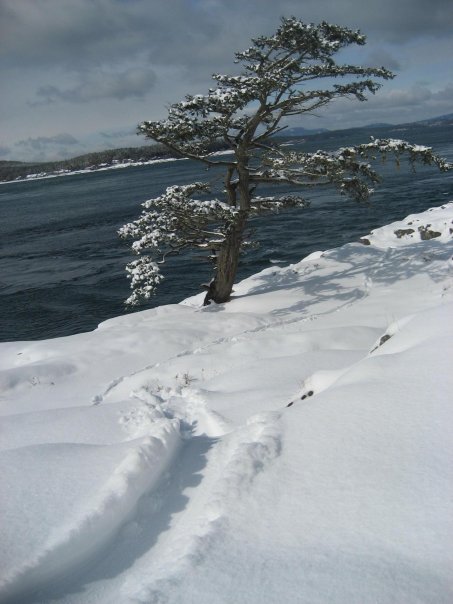My 12-year-old has been teasing me about how I’m more wound up about the prospect of new snow than she is…and she might be right (I’m wide awake at 3 am writing this because I’m so excited for the onslaught that I can’t sleep).
There’s something about how snow transforms every tarp, bucket and stump to create a monochrome sculpture park—all is forgiven. I enjoy the minutely exquisite symmetry of a snowflake, and trying to get close enough to discover its individual secret before my breath transforms it into a common drop of water. Scraggly bare branches adorned in frosty coats become beguiling artistic studies. Not to mention the joyful abandonment that is sledding, and the rare island event: cross-country skiing to the neighbor’s for a cuppa.
Waiting for snow also evokes childhood mornings, impatiently listening to the DJ recite school closures…breathless in the kitchen with my sister, poised for the door (snow pants and mittens already on)—please oh please let them call our school…the rush of relief and excitement when they did….SNOW DAY!
In recent years I’ve discovered yet another reason to revel in a snow day: animal tracking. Last winter I had the chance to interview expert tracker David Moskowitz, who shared a few insights into what he believes is an accessible pastime for everyone, and a great way to inspire people to care more deeply about wild places.
“The snow creates a blank slate and these animals come and write their stories onto it,” says Moskowitz, author of the tracking field guide, Wildlife of the Pacific Northwest. “Snow provides a very simple substrate where you can detect tracks, and so it’s a great doorway for novices. And because often you get long strings of tracks in the snow, you can literally follow an animal for hours.”

Animals leave more than foot tracks…this impression is an otter slide, created by river otters playing in the snow (photographed on Lopez Island by Kathryn True).
Stories in the snow
Moskowitz, who teaches tracking through the Wilderness Awareness School in Duvall, says that tracks tell stories about what happened the night before, and you can go out, pick up the tale, and try to put it all together.
Naturally, heading up into the mountains you’ll see a much wider variety of animal tracks, but the island is a great place to practice your track identification skills, and you might be surprised at what you discover. Looking very closely at some bird tracks in the snow last year I found several perfect imprints of small wings. It looked as if a bird had been making row upon row of tiny snow angels. And even if you only find the tracks of deer or raccoon (or even a domestic cat or dog), their stories can bring new insights into the lives of our animal neighbors.
For example, it’s surprising to discover raccoon tracks heading up the steps to your deck, and interesting to try to determine just which way a deer was headed (the narrow part of the track—actually its two front toes—is at the front). Or take a look at the straight-line tracks of the housecat and consider its gait. And ponder the circling dances of rodent tracks—are they the messages of mouse or vole?
If you don’t have a tracking guide and want to get started now, check out the Alderleaf Wilderness College website for a guide to several common local animal tracks. Vashon Wilderness School will be offering a tracking workshop for teens in March.
Whatever you do today, get out and enjoy the snow like the otters do!
